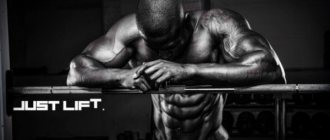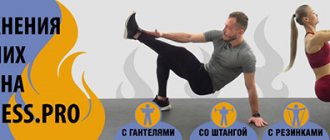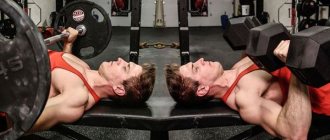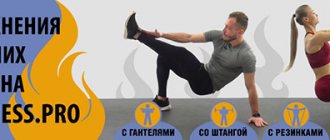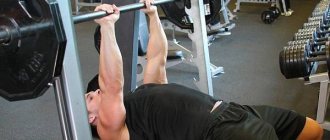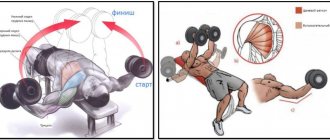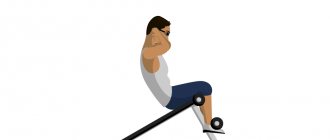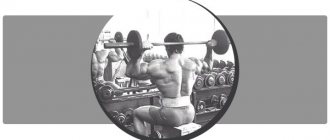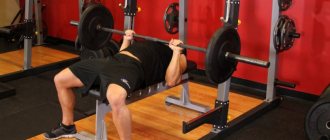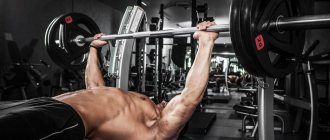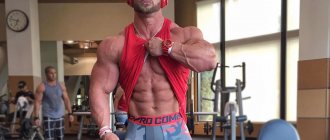The incline bench press exercise pumps up the upper chest. Expands and lifts the top of the pectoral muscles. Formative exercise.
The incline press is the most useful exercise for developing all the muscles of the shoulder girdle. It puts more stress on the upper pecs, “the hardest to pump,” and deltoids, as opposed to the standard bench press.
Thanks to the positive angle of the bench, the entire load is focused on the upper chest, highlighting and expanding this area.
When you do an incline bench press, the muscles in your torso and arms work in much the same way as when throwing a javelin, throwing a ball from your chest with both hands in basketball, throwing a straight punch in boxing, or pushing an opponent with both hands in rugby.
Bench press on an incline bench - an exercise for the pectoral muscles
Description of the exercise
The incline press is an effective chest exercise. Correct execution makes it possible to get the first result in a short time.
What muscles work
An exercise such as the incline bench press is a basic exercise, the purpose of which is aimed at pumping the pectoralis major muscle, as well as the triceps and anterior deltoids. Also during the training process, auxiliary muscles are used, as well as other muscle groups that are under tension.
Benefit
Most of the load with this exercise will fall on the central part of the chest. If a need arises such as pumping the upper or lower chest, then a wide variety of angle press variations can be used.
When the body is in an inclined position, the working muscle groups do not change, but the load is distributed slightly differently.
The load can vary and it depends on what angle is chosen:
- Dumbbell press at an angle of 30 degrees - when choosing this angle, most of the load will be directed to the middle part and partly the top of the chest.
- An angle of 45 degrees - in this case, a large load is transferred to the upper part, while freeing the middle one.
- An angle of 60 degrees - some part of the load will affect the upper chest muscles, and the main part will be directed to the front deltoids, as well as triceps.
Contraindications
The press is contraindicated for people who have problems with their shoulder joints. If the health problems that arise are not critical, then performing the exercise with a barbell can be replaced with dumbbells, which reduce the load. This, in turn, will allow the shoulders to move more freely and adapt to the trajectory of the projectile.
If an athlete has back problems due to a previous injury, then he will need to control the deflection in the lumbar region. In this case, the exercise must be performed with caution.
Execution technique
Finally we have reached the most important thing. Now you know why you should do an incline press, it's time to learn how to do it correctly!
As always, we start with a warm-up. To begin with, an empty bar will do; you will need to do 10–15 repetitions at an average pace, but without throwing it sharply up and down.
- Set the desired angle of the bench back. Sit on it so that your pelvis is pressed against the seat and your back is against the backrest. Spread your legs to the sides and rest your heels on the floor.
- Leave a natural arch in your lower back. Bring your shoulder blades together; they should rest against your back. Place your head on the back, look at the top of the wall opposite you.
- Grasp the bar with a straight grip, wider than shoulder width, focusing on the marks. On each of the marks of the bar (right and left) there should be a finger of your hand (usually the middle or ring finger, depending on the length of the athlete’s arms).
- Remove the bar from the racks and bring it to its starting position: it should be located above your collarbones.
- Lower the bar to the top of your chest as you inhale. Without holding your breath, exhale and push the barbell up. Control your movement at every stage! You don't need to throw the barbell on your chest, just as you don't need to push it up uncontrollably.
When you have completed the required number of warm-up reps, put the bar back, hang the working weight and do 3 sets of 8 repetitions.
Preparation for execution
Before you start working with a special block, you need to do warm-up exercises. In order to perform a bench press, the muscles must be properly prepared, and then they can quickly connect when performing physical exercises.
To warm up the muscles, it is recommended to perform special joint exercises. This includes performing movements with increasing amplitude.
In order to prepare the muscles for performing the technique, it is recommended to do the following:
- Ordinary push-ups from the floor without using weights.
- Stretches for the chest: dumbbell lifts, pullovers. These exercises are necessary so that during further training the muscles are relaxed, and the implementation of sets is more effective in the following approaches.
Bench press at an angle video exercise
Brief conclusions
The incline barbell press is considered basic for improving the muscles of the upper segment of the body, forming a wide and powerful chest. Anatomically, the technique resembles push-ups, but the use of a barbell allows you to use additional weight.
Correct execution of the incline bench press technique requires that the feet are pressed to the floor, the shoulder blades are retracted, and a minimum deflection is maintained in the back. The pelvis is pressed against the support bench. The barbell must be lowered diagonally, and at the lowest point of the amplitude, do not lower it all the way to the collarbones.
Author: ForceMan from 04/06/2018, 07:00
- 0
Basic mistakes
Athletes often make the following mistakes when performing bench presses while lying on an incline bench:
- Wrist flexion. If you make such a mistake, it can lead to injury. You should strictly control the palms lying on the bar. It is important that they are always located in line with the forearms.
- Lowering the barbell to the center of the chest. This mistake can be made by athletes who have already developed the skill of moving with a classic bench press. An exercise with a barbell on a bench requires a change of direction towards the collarbone area.
- Springy blows with the bar on the chest. With the help of cheating, you can significantly facilitate the lifting of working weight, but this method is not safe. Using this method may result in injury.
- Incorrect grip. The correct technique is to use a locking overhand grip, with the thumb positioned opposite the rest. This, in turn, ensures that the exercise will be performed as safely as possible.
- Using weights that are used for horizontal bench presses.
A few words for girls
If you are a girl and somehow you are concerned about the incline press and you found this article - I want to reach out to you. To begin with, I will say that there are quite a few muscles in your chest that need a strong workout.
Due to your feminine nature, the bulk of your muscles are concentrated in the lower part of your body. That's why your legs are naturally stronger than guys. And in men, the torso (upper body) is stronger than the legs. Therefore, a man and a woman are two opposites also on this basis.
This suggests that you should not pay too much attention to chest training, since there is no point in it in the first place. That is, there is no point in dedicating a separate day for chest training! You just need to pump it up a little...
I advise you to perform dumbbell presses on an incline bench as your main chest exercise! It is recognized as the most effective! You can do this at the very beginning of your workout.
Be sure to read the additional article on my blog about pumping up female breasts. There I described this issue in detail - you will learn many useful points.
But to put it briefly, there are VERY FEW MUSCLES in the female breast and its main volume is made up of the following parts:
FAT + GLAND (mammary gland) + CONNECTIVE
Tips and tricks
By following the advice, the athlete will receive maximum benefit and minimum harm from performing the bench press.
Which angle to use
The smaller the angle chosen, the less stress will be placed on the target chest muscles. The most correct solution would be to choose a tilt level from the horizontal of 30 degrees. This in turn will help to load the triceps. There is no need to choose too high an angle of inclination, as this will subsequently lead to severe tension on the shoulder joints.
How to enhance the effect
To enhance the effect of training on an incline bench press, it is recommended:
- Try to tense your chest muscles as much as possible, then focus all your attention on this and continue training.
- Make sure that when performing the exercise there is no gap between your back and the support. Otherwise, muscle work will be complicated. A better solution would be to perform the exercise on a bench that has foot rests.
Other practical tips
You should also follow these tips:
- when exercising, the barbell should not move in your hands;
- during the exercise, you should make sure that the natural arch in the lower back has been maintained;
- when performing the technique, you should make sure that the shoulder blades are kept together at all times;
- the bar of the bar should fall onto the collarbones and for this, in some cases, you will need to move your head back.
Important points
Before you start training, pay attention to a number of important points.
Insurance
Removing the barbell with an incline press is more difficult than with a classic press. Therefore, you will need an assistant. Have someone help you remove the barbell. Have the person stand nearby while you do the exercise. Putting the barbell back is no less difficult, so you will need help here too.
When you're working at 60-75% of your maximum weight, you can do it all yourself. Failure approaches require insurance.
Support points
During the exercise, you rely on your buttocks, back and legs. Usually, beginners lift their pelvis off the bench. With a seated incline press, this is even more dangerous than with a classic one, since the weight also presses on you in the vertical plane (even if only slightly).
Don't lift your pelvis off the bench!
Trying to make a bridge
When you try to get into a bridge with such a bench press, all sense of 45 or 30 degrees is lost. Due to your bridge, you zero this angle. There is no need to bend like this; a natural arch in the lower back is enough.
Bench press
A trainer can give you a Smith bench press after the classic one. This is normal and allows you to pump the upper chest in isolation. Everything is done here in exactly the same way as when working with a free barbell. Only the task is made easier - the bar is fixed and moves strictly in a vertical plane.
It is best, of course, to work with free weights. Let other muscles be involved to stabilize the position of the barbell.
What to do for shoulder pain
If you have pain in your rear deltoids, it will not affect your incline press. If it’s in the middle or front, everything is much more complicated.
Decide by experimenting with light weights at what angle you feel most comfortable pressing. If pain haunts you in absolutely any bench press, you will have to exclude these exercises for a month or two.
If, for example, you don’t feel pain at an angle of 45 degrees, you can work. But those exercises in which you feel discomfort should be excluded.
Before the exercise, warm up well and use special ointments. Listen carefully to your body. If pain appears anywhere, stop exercising immediately! In a warm state, the athlete may not immediately understand that a sprain has occurred. This will appear after training, when the muscles have cooled down.
It may not hurt you to do a head down barbell press. It doesn't work the shoulders as much as the triceps and chest.
How often to do incline presses
If you divide chest exercises into 2-3 days, you can do different variations of bench presses 3 times a week.
For example, a bench press at an angle of 30 degrees in the first workout, followed by flyes and a dumbbell press at 45 degrees.
In the second workout, after dips, you can do an incline bench press while sitting at 45 degrees and finish with the same setup.
If you alternate between light and heavy training, you should do the same, but with the current weights. For example, if today is an easy workout, the weights should be less than your failure weights.
Examples of ready-made exercise complexes
This option is basic, and it is intended for training in the gym in order to effectively work out all parts of the pectoral muscles:
- Bench press with wide grip barbell - 4x5-12.
- The layout of dumbbells in a horizontal position on a bench is 4x8-10.
- Dumbbell press - 4x12-15.
- Bench press on an inclined bench - 3x11-13.
- Barbell press in a head down position - 4-12-15.
A break is allowed between approaches in each of the presented exercises, but it should not be more than 45 seconds to 1 minute.
When burning excess fat deposits, the option for training the pectoral muscles looks like this:
- Bench press on a bench - 4x12-15.
- Pressing dumbbells on a bench with an inclined direction of 4x12-15.
- Dips without weights - 3x15-20.
- Raising dumbbells on a bench with a horizontal direction - 4x15-20.
- Hand combinations in a butterfly or crossover - 3x15-20.
Between sets of each exercise, a break of no more than 45 seconds to 1 minute is allowed.
How to do a bent over press correctly
Here are just the main points that must be taken into account when doing the incline bench press:
- HANDS POSITION This is very important, since it determines which muscle groups work in the process. The wider your grip, the more your pecs are recruited. In my opinion, the most optimal grip is shoulder-width apart. You can take a wider grip, but in this case you need to make sure that your elbows are parallel to your body. There is no need to separate them, in this case the triceps muscles begin to work, and this is bad. Different grip variations can also help pump up your chest. A wide grip, for example, pumps not only the upper chest, but also the middle. This happens because the body automatically tries to evenly distribute the load on the muscles.
- FOOT POSITION. Also, the bridge (that same arch in the lower back) should be excluded from the exercise, so the legs should be located on a hill. You can throw them on the bench in front of you or come up with something. You will find your way around the place. Not everyone does this. In the gym where I trained for more than 7 years, only a few did this (I only saw 2-3 people). Usually everyone’s feet are on the floor, but then it’s difficult to remove the bridge. Just for fun, try it. It won't be familiar, that's for sure. But what can you do for a more effective workout!
- SPEED. This is the best place to feel the speed. I never thought about speed when doing this exercise. My feelings have always been important to me. Some people lower the projectile slowly and raise it slowly, others press it quickly. Depending on this, different types of muscle fibers are involved in the work. Therefore, my opinion is that you need to combine. Initially perform in a slow mode - then add “explosive approaches” at high speed. This will allow you to surprise your muscles, and this always leads to progress. But if you work on an incline bench too quickly, you are more likely to get injured or put unnecessary stress on your body, which will negatively affect your recovery.
- POINT OF LOWERING OF THE NECK. A very important point! For a long time I didn’t know that I was making one serious mistake. For a long time, when performing incline presses, I lowered the bar towards my nipples. It was a period of unconscious training. But in fact, you need to lower the bar to your Adam’s apple, that is, to your neck. The ideal option is between the nipples and neck. Then the breasts really work. Remember this moment and try this. Feel the difference!
- BREATH. Of course, you shouldn’t forget about this. This is important when performing any other exercise. We lower the bar - inhale, raise it - exhale. Do not hold your breath, as this increases blood pressure and pressure inside the eyes. The face becomes too red. You will be like Signor Tomato). Obvious, but a good reminder for newbies!
I would also like to talk about the classic bench press so that you remember some of its differences from the inclined one. If you do it, then you can and should also remove the bridge by raising your feet on the bench. It is advisable to lower the bar towards the neck (this feature is called the “guillotine”), and not between the neck and nipples, as in the incline press. The grip should be wide with good stretch (in the incline press, the grip is not very wide, average).
Well, don't forget about safety. Ask for backup if you are not sure that you can complete all the repetitions in a set. Ask an experienced person to look at you from the outside to correct your technique if necessary.
Advantages and disadvantages of the Smith machine
Like any other simulator, the Smith machine has its pros and cons. Let's start with the positive features:
- The simulator is suitable for beginner athletes who are not confident in performing exercises and can easily get injured.
- During training, the main muscle groups work in the Smith machine, and additional, or secondary, ones are turned off for the duration of a particular exercise.
- It becomes possible to perform exercises without an assistant, who most often provides belay on some other simulators.
- The Smith machine allows you to stimulate muscle growth well.
Among the disadvantages of this simulator are the following:
- Considering the second plus of the simulator, you can also find a negative side in it, because with the stable development of large muscles, you can observe a lag in additional ones, which is quite difficult to change in the future. Therefore, it is important to simultaneously train for secondary muscles.
- Having gotten used to working in a Smith machine, an athlete can unlearn performing the same exercises with free weights, and this is fraught with injury.
The correct approach to using the Smith machine will allow you to develop large muscle groups and build muscle mass while maintaining your health.
Smith Bench Press
- This is a basic exercise, which is an analogue of the classic bench press, its action is aimed at developing the pectoral muscle. The technique is similar to working with free weights.
However, due to the fact that the exercise is performed according to a strictly specified amplitude of the guides, the movement is more accentuated and provides the opportunity to work out the muscle fibers of the chest 100%.
Benefits of doing the Smith Bench Press
1. The simulator allows you to perform the exercise without a safety partner.
2. Using extreme weights without the possibility of injury.
3. The Smith machine allows you to perform heavy negative repetitions without compromising your technique or harming your ligaments and joints.
4. Due to the fact that the bar moves along guides, beginning athletes are given an excellent opportunity to practice the correct technique for performing the classic bench press.
5.Athletes who have been injured can continue to train without additional stress on the injured ligaments and joints, purposefully working only the necessary muscle group.
The Smith machine provides the opportunity to pump up beautiful chests and develop the athlete's absolute strength without the additional risk of injury.
Technique for performing the bench press on a Smith machine
1. The first thing you need to do is adjust the position of the bench under the machine. Use a slight tilt angle, which should be between 20 and 30 degrees. This is necessary to better emphasize the load on the lagging upper chest and relieve the work of the triceps and deltoids.
2. The bench under the machine must be positioned so that when the bar is lowered to the end point of the negative phase, it touches directly the lower part of the chest.
3. Take the starting position and remove the barbell from the clamps of the machine. Keep your legs relaxed: this is necessary so as not to shift the load from the chest to the auxiliary muscle groups.
4. Your back should touch the bench with its entire plane, do not use additional bends, keep your shoulder blades in a contracted position until the end of the exercise.
5. Select the grip width so that when lowering the barbell to the lowest point, your forearms are parallel at an angle of 90 degrees. This position of the hands will ensure correct transfer of the load to the working muscle group during the exercise.
6. Keep your hands in a strictly fixed position and do not bend them, otherwise you may get injured.
7. Take a deep breath and smoothly perform the negative phase of the movement. When the bar touches the bottom of your chest, pause for two seconds to stretch the muscle fibers as much as possible.
8. Keep your head on the bench to prevent injury and focus as much as possible on working your pectoral muscles.
9. Exhale sharply and return the barbell to its original position with a controlled movement. Use the technique described above and complete the prescribed number of sets and reps.
Low bow, my dears! It’s been a while since we’ve been technical and haven’t dealt with the practical component of training. Let’s do just that today using the example of a debriefing exercise, the barbell press on an incline bench. After reading, each of you will learn everything about the advantages, technique, and secret tricks of the incline press. We will also find out what type of bench press is considered the best for the growth of pectoral muscles and in what...well, I won’t reveal all the trump cards in order to maintain the intrigue.
So, I ask everyone to take their seats in the auditorium, I give the third bell, let's go.
What muscles work when you press a barbell upside down on an incline bench?
As already mentioned, due to the inclination, the triceps are less involved in this version of the exercise, but the pectoral muscles do all the main work. The anterior deltoid muscles also go into battle. Another important point will be the correct position on the bench. The more tightly the athlete sits on his back, the more the pectoral muscles will be involved. But when performing an exercise with a deflection (bridge), which is a violation of the exercise technique, the load on the chest muscles is distributed to the triceps and deltoids.
The abdominal muscles and serratus anterior muscles are also involved when performing.
Smith Incline Bench Press
This variation of the exercise can be considered an excellent way to train with heavy weights without support. Also, the incline press in the Smith machine is suitable for women or beginners in the gym, since the incline press in the Smith machine takes the load off the stabilizer muscles. Therefore, for those who cannot independently hold a barbell and perform an exercise on an incline bench, the Smith machine will be a good option for preparing for free weights.
